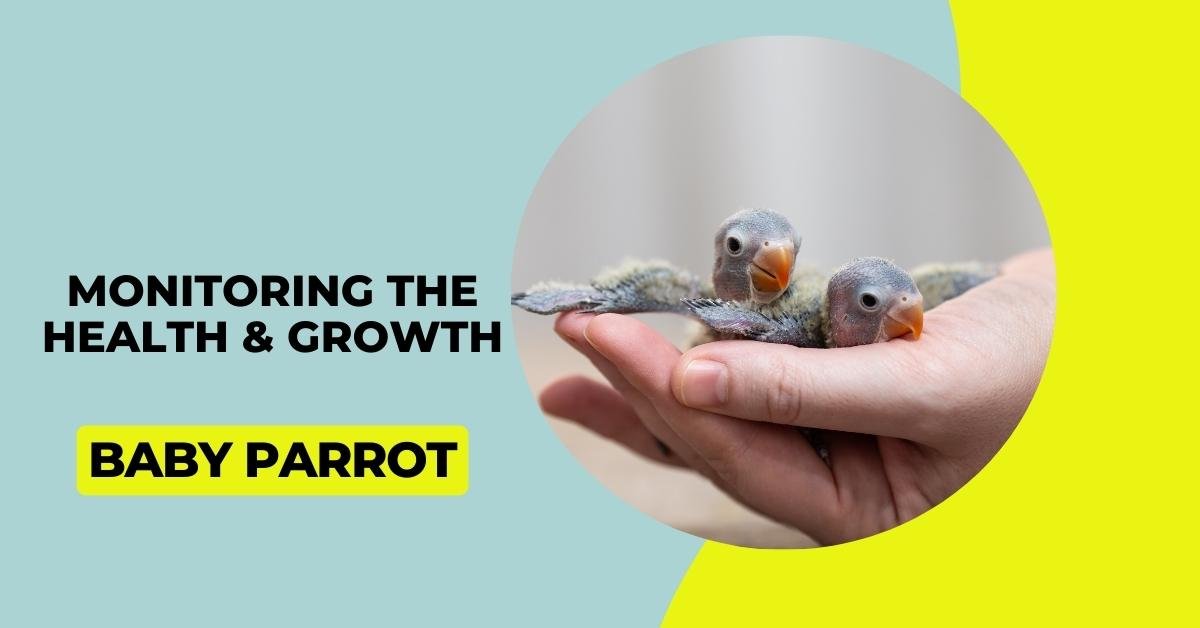Ensuring the health and growth of baby parrots is essential for their development into healthy, vibrant adults. Monitoring their progress and awareness of common health issues are crucial to providing the best care. In this guide, we’ll explore the signs of healthy growth and development, identify common health issues to watch for, and when to seek professional help.
Monitoring the Health and Growth of Baby Parrots
Signs of Healthy Growth and Development
Monitoring your baby parrot’s health and growth involves observing several key indicators:
- Weight Gain: Baby parrots should steadily gain weight as they grow. Regularly weighing them can help track their progress. Use a kitchen scale or a designated bird scale for accuracy.
- Feather Development: The growth of healthy feathers is an essential sign of overall health. Vibrant, shiny, well-formed feathers show the bird receives proper nutrition and care.
- Appetite: A healthy baby parrot will have a good appetite and eagerly consume food. They should show enthusiasm during feeding times, actively reach for food, and show interest in their surroundings.
- Activity Level: Active and playful behaviour indicates good development. They should engage in exploratory behaviours, such as climbing, hopping, and playing with toys.
- Vocalization: Baby parrots will gradually start producing sounds as they grow. Initially, their vocalizations may be soft and limited, but they should become more varied and distinct.
Baby Parrot Growth Chart
| Week | Weight (grams) | Feather Development | Activity Level | Vocalization |
|---|---|---|---|---|
| 1 | 15-20 | Sparse, downy feathers | Minimal, nest-bound | Soft chirps |
| 2 | 25-30 | More down feathers | Starting to explore the nest | Slightly louder chirps |
| 3 | 35-40 | Pin feathers emerging | Increased movement | Varied chirps |
| 4 | 50-55 | Feathers growing longer | Active in nest | Louder, more distinct sounds |
| 5 | 60-65 | Mostly feathered | Exploring surroundings | Attempting to mimic sounds |
| 6 | 70-75 | Fully feathered | Very active, playing | Clear, varied vocalizations |
Monitoring the Health and Growth of Baby Parrots: Step-by-Step Guide
- Daily Weight Monitoring
Weigh your baby parrot every day using a digital scale. Healthy growth should be steady, with slight increases in weight daily. - Check Feeding Response
Monitor how well the parrot responds to feeding. A healthy baby parrot will eagerly eat when offered food and show signs of satiety after feeding. - Observe Physical Development
Regularly inspect their feathers, beak, and claws for healthy growth. Feathers should start appearing within the first few weeks, with vibrant and even coloring. - Assess Activity Levels
A healthy baby parrot is active and alert. Track how often they move, explore, and react to sounds and stimuli around them. - Monitor Droppings
Check their droppings for any changes in color, consistency, or frequency. Healthy droppings are firm and consistent in shape. - Hydration Check
Ensure they are staying hydrated by checking their water consumption. Dehydration can lead to health complications, so always provide fresh, clean water. - Skin and Feather Condition
Regularly check the parrot’s skin for any signs of dryness, irritation, or feather loss. Healthy skin is smooth, and feathers should grow evenly. - Veterinary Health Checkups
Schedule regular veterinary visits to monitor overall health, ensuring your parrot’s growth is on track, and address any potential health concerns. - Track Mental and Social Development
As they grow, your baby parrot should become more curious and social. Track their interactions with you and other birds to ensure proper mental and social development. - Monitor Breathing and Vocalization
Keep an ear on their breathing and vocal sounds. Wheezing, heavy breathing, or abnormal sounds could indicate respiratory issues that need attention.
Common Health Issues to Watch Out
While monitoring your baby parrot’s health, be vigilant for any potential health issues:
- Inadequate Weight Gain: If a baby parrot fails to gain or lose weight, it could indicate a nutritional deficiency or illness. Consult a veterinarian for guidance in adjusting the bird’s diet or providing medical treatment.
- Feather Issues: Abnormal feather growth, excessive feather plucking, or bald spots are signs of underlying health problems. Seek immediate veterinary assistance to diagnose and address the issue.
- Unusual Droppings: Changes in the parrot’s color, consistency, or frequency can indicate digestive or metabolic problems. Monitor their droppings closely and consult a veterinarian if you notice any abnormality.
- Respiratory Distress: Wheezing, laboured breathing, sneezing, or coughing could indicate respiratory infections, allergies, or respiratory tract obstructions. Seek professional help promptly for appropriate treatment.
- Behavioural Changes: Sudden changes in behaviour, such as increased aggression or prolonged periods of inactivity, may be a cause for concern. Consult a veterinarian to rule out any potential health issues.
Tips for Ensuring Healthy Growth and Development
- Balanced Diet: Provide a variety of foods to meet their nutritional needs.
- Regular Check-ups: Schedule regular veterinary visits to monitor their health.
- Clean Environment: Maintain a clean and safe living space to prevent infections.
- Social Interaction: Spend time with your parrot to promote mental and emotional well-being.
- Observant Care: Pay attention to behavior, appetite, or appearance changes.
Conclusion
Caring for baby parrots involves careful monitoring of their health and growth. By observing signs of healthy development and being aware of potential health issues, you can ensure your baby parrot thrives. If you notice any concerning signs or are unsure about their health, always seek professional advice from an avian veterinarian. This proactive approach will help your baby parrot grow into a healthy and happy adult.
